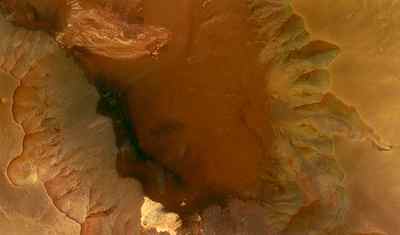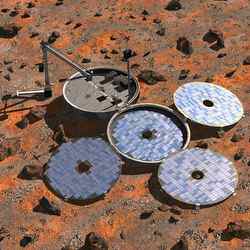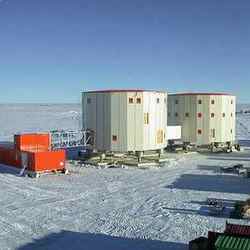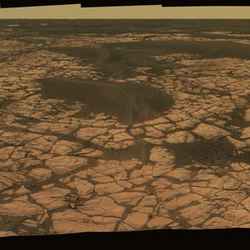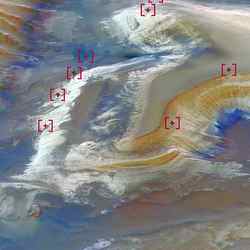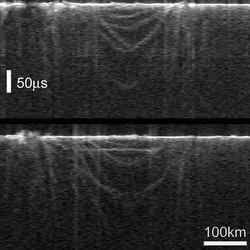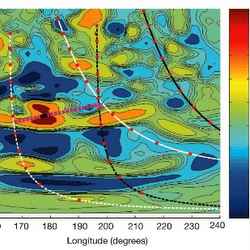
Location of aurora on Mars. Image credit: ESA Click to enlarge
Auroras similar to Earth’s Northern Lights appear to be common on Mars, according to physicists at the University of California, Berkeley, who have analyzed six years’ worth of data from the Mars Global Surveyor.
The discovery of hundreds of auroras over the past six years comes as a surprise, since Mars does not have the global magnetic field that on Earth is the source of the aurora borealis and the antipodal aurora australis.
plot of the 13,000 auroral events on Mars
According to the physicists, the auroras on Mars aren’t due to a planet-wide magnetic field, but instead are associated with patches of strong magnetic field in the crust, primarily in the southern hemisphere. And they probably aren’t as colorful either, the researchers say: The energetic electrons that interact with molecules in the atmosphere to produce the glow probably generate only ultraviolet light – not the reds, greens and blues of Earth.
“The fact that we see auroras as often as we do is amazing,” said UC Berkeley physicist David A. Brain, the lead author of a paper on the discovery recently accepted by the journal Geophysical Research Letters. “The discovery of auroras on Mars teaches us something about how and why they happen elsewhere in the solar system, including on Jupiter, Saturn, Uranus and Neptune.”
Brain and Jasper S. Halekas, both assistant research physicists at UC Berkeley’s Space Sciences Laboratory, along with their colleagues from UC Berkeley, the University of Michigan, NASA’s Goddard Space Flight Center and the University of Toulouse in France, also reported their findings in a poster presented Friday, Dec. 9, at the American Geophysical Union meeting in San Francisco.
Last year, the European spacecraft Mars Express first detected a flash of ultraviolet light on the night side of Mars and an international team of astronomers identified it as an auroral flash in the June 9, 2005, issue of Nature. Upon hearing of the discovery, UC Berkeley researchers turned to data from the Mars Global Surveyor to see if an on-board UC Berkeley instrument package – a magnetometer-electron reflectometer – had detected other evidence of auroras. The spacecraft has been orbiting Mars since September 1997 and since 1999 has been mapping from an altitude of 400 kilometers (250 miles) the Martian surface and Mars’ magnetic fields. It sits in a polar orbit that keeps it always at 2 a.m. when on the night side of the planet.
Within an hour of first delving into the data, Brain and Halekas discovered evidence of an auroral flash – a peak in the electron energy spectrum identical to the peaks seen in spectra of Earth’s atmosphere during an aurora. Since then, they have reviewed more than 6 million recordings by the electron reflectometer and found amid the data some 13,000 signals with an electron peak indicative of an aurora. According to Brain, this may represent hundreds of nightside auroral events like the flash seen by the Mars Express.
When the two physicists pinpointed the position of each observation, the auroras coincided precisely with the margins of the magnetized areas on the Martian surface. The same team, led by co-authors Mario H. Acu?a of NASA’s Goddard Space Flight Center and Robert Lin, UC Berkeley professor of physics and director of the Space Sciences Laboratory, has extensively mapped these surface magnetic fields using the magnetometer/reflectometer aboard the Mars Global Surveyor. Just as Earth’s auroras occur where the magnetic field lines dive into the surface at the north and south poles, Mars’ auroras occur at the borders of magnetized areas where the field lines arc vertically into the crust.
Of the 13,000 auroral observations so far, the largest seem to coincide with increased solar wind activity.
“The flash seen by Mars Express seems to be at the bright end of energies that are possible,” Halekas said. “Just as on Earth, space weather and solar storms tend to make the auroras brighter and stronger.”
Depiction of surface magnetic fields on Mars
Earth’s auroras are caused when charged particles from the sun slam into the planet’s protective magnetic field and, instead of penetrating to the ground, are diverted along field lines to the pole, where they funnel down and collide with atoms in the atmosphere to create an oval of light around each pole. Electrons are a big proportion of the charged particles, and auroral activity is associated with a physical process still not understood that accelerates electrons, producing a telltale peak in the spectrum of electron energies.
The process on Mars is probably similar, Lin said, in that solar wind particles are funneled around to the night side of Mars where they interact with crustal field lines. The ultraviolet light is produced when the particles hit carbon dioxide molecules.
“The observations suggest some acceleration process occurs like on Earth,” he said. “Something has taken the electrons and given them a kick.”
What that “something” is remains a mystery, though Lin and his UC Berkeley colleagues lean towards a process called magnetic reconnection, where the magnetic field traveling with the solar wind particles breaks and reconnects with the crustal field. The reconnecting field lines could be what flings the particles to higher energies.
The surface magnetic fields, Brain said, are produced by highly magnetized rock that occurs in patches up to 1,000 kilometers wide and 10 kilometers deep. These patches probably retain magnetism left from when Mars had a global field in a way similar to what occurs when a needle is stroked with a magnet, inducing magnetization that remains even after the magnet is withdrawn. When Mars’ global field died out billions of years ago, the solar wind was able to strip the atmosphere away. Only the strong crustal fields are still around to protect portions of the surface.
“We call them mini-magnetospheres, because they are strong enough to stand off the solar wind,” Lin said, noting that the fields extend up to 1,300 kilometers above the surface. Nevertheless, the strongest Martian magnetic field is 50 times weaker than the field at the Earth’s surface. It’s hard to explain how these fields are able to funnel and accelerate the solar wind efficiently enough to generate an aurora, he said.
Brain, Halekas, Lin and their colleagues hope to mine the Mars Global Surveyor data for more information on the auroras and perhaps join with the European team operating the Mars Express to get complementary data on the flashes that could solve the mystery of their origin.
“Mars Global Surveyor was designed for a lifetime of 685 days, but it has been very valuable for more than six years now, and we are still getting great results,” Lin observed.
The work was supported by NASA. Coauthors with Brain, Halekas, Lin and Acu?a are Laura M. Peticolas, Janet G. Luhmann, David L. Mitchell and Greg T. Delory of UC Berkeley’s Space Sciences Laboratory; Steve W. Bougher of the University of Michigan; and Henri R?me of the Centre d’Etude Spatiale des Rayonnements in Toulouse.
Original Source: UC Berkeley News Release
